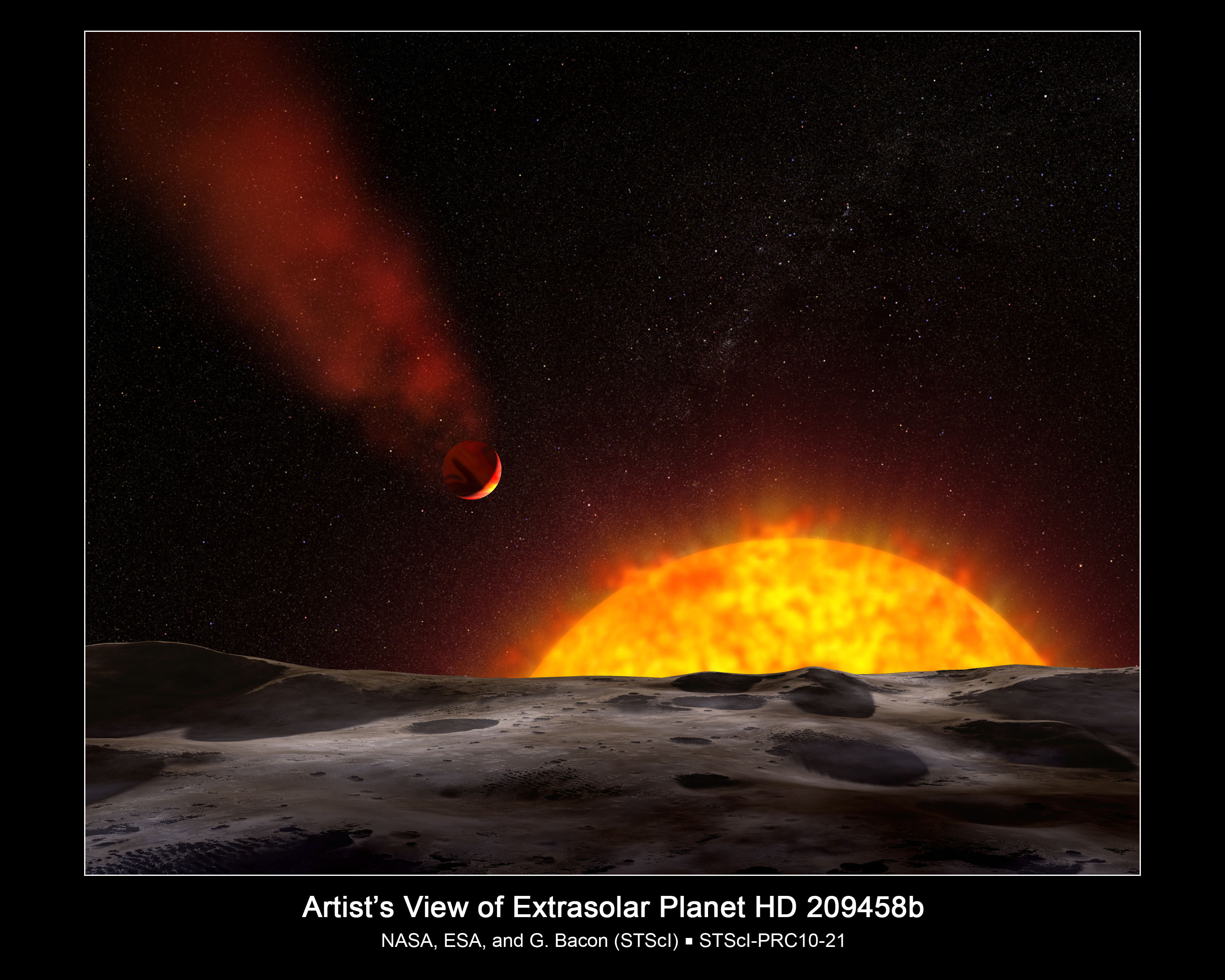Next time you hear someone complaining that it’s too hot outside, you can make them feel better by pointing out that at least their planet isn’t so hot it is vaporizing into space. Unless of course you happen to be speaking to someone from the gaseous extrasolar planet HD 209458b.
New observations from the Hubble Cosmic Origins Spectrograph (COS) confirm suspicions from 2003 that the planet HD 209458b is behaving like a Jupiter-sized comet, losing its atmosphere in a huge plume due to the powerful solar wind of its too-close star.
HD 209458b is a “hot Jupiter”: a gas giant that orbits extremely close to its star. It whips around its star in 3.5 days, making even speedy little Mercury with its 88 day orbit around the sun look like a slacker.
Astronomers have managed to learn a lot about HD 209458b because it is a transiting planet. That means that its orbit is aligned just right, so from our point of view it blocks some of the light from its star. When that happens, it gives hints at the planet’s size, and gives a much better constraint on the mass. HD 209458b is a little more than two thirds the mass of Jupiter, but heat from its star has puffed it up to two and a half times Jupiter’s diameter.
In the case of HD 209458b, during transits some of the star’s light passes through the planet’s escaping, 2,000-degree-Fahrenheit atmosphere, allowing scientists to tell what it is made of and how fast it is being lost to space.
“We found gas escaping at high velocities, with a large amount of this gas flowing toward us at 22,000 miles per hour,” said astronomer Jeffrey Linsky of the University of Colorado in Boulder, leader of the COS study. “This large gas flow is likely gas swept up by the stellar wind to form the comet-like tail trailing the planet.”
The escaping planetary gases absorbed starlight at wavelengths characteristic of heavier elements like carbon and silicon, suggesting that the star’s intense heat is driving circulation deep in HD 209458b’s atmosphere, dredging up material that would otherwise remain far beneath lighter elements like hydrogen.
Even though its atmosphere is constantly streaming away into space, HD 209458b won’t be disappearing anytime soon. At the measured rate of loss, the planet would last about a trillion years, far longer than the lifetime of its host star.
So, be thankful that even on hot summer days, your planet is in no danger of being vaporized by its star. And if you do happen to be speaking to someone from HD 209458b, you can reassure them that their planet will still be there when they return home. Well, most of it, anyway.
Oh, and remind them to stock up on sunscreen.


What a strange sight, a comet-like tail trailing an exoplanet! It seems we’ll learn that many of the expoplanets that we study going forward will exhibit characteristics and phenomena that are entirely foreign to any we experience in our Solar System. 2K degrees surface temp? And I’m complaining about 102 F. here in N. Ca. today!
Ugh! exoplanets, not expoplanets, although many do provide an entertaining exposition!
I’m confused about the tail issue. In the press release, they say COS confirmed the tail, yet the paper suggests otherwise:
“The presence of gas in an extended tail should produce more absorption at and beyond egress than during ingress phases. Schneiter et al. (2007) calculated possible cometary wakes and the time evolution of Lyman-a absorption from ingress to beyond egress. We searched our C II and Si III spectra for line profle differences between the ingress and egress phases to see whether these ions could be present in significant amounts in a tail, but we found no differences larger than the noise level. Future observations with higher S/N are required to verify the predictions of comet-like tails.”
From what I gather, after reading the PR and the paper ( http://hubblesite.org/pubinfo/pdf/2010/21/pdf.pdf ), the researchers are taking a more conservative stance regarding their observations than the PR alludes to (as sometimes happens). Also from the PR(but not included in the article above):
“”Since 2003 scientists have theorized the lost mass is being pushed back into a tail, and they have even calculated what it looks like,” said astronomer Jeffrey Linsky of the University of Colorado in Boulder, leader of the COS study. “We think we have the best observational evidence to support that theory. We have measured gas coming off the planet at specific speeds, some coming toward Earth. The most likely interpretation is that we have measured the velocity of material in a tail.” ”
From the paper:
“Comparison of the CII and SIII line depths and transit/non-transit line ratios shows deeper absorption features near -10 and +15km/s and less certain features near -40 and +30-70km/s, but future observations are needed to verify this first detection of velocity structure in the expanding atmosphere of an exoplanet.”
So it looks like a comet-like tail exists wrt HD 209458b, but more data is needed to substantiate this conclusion.